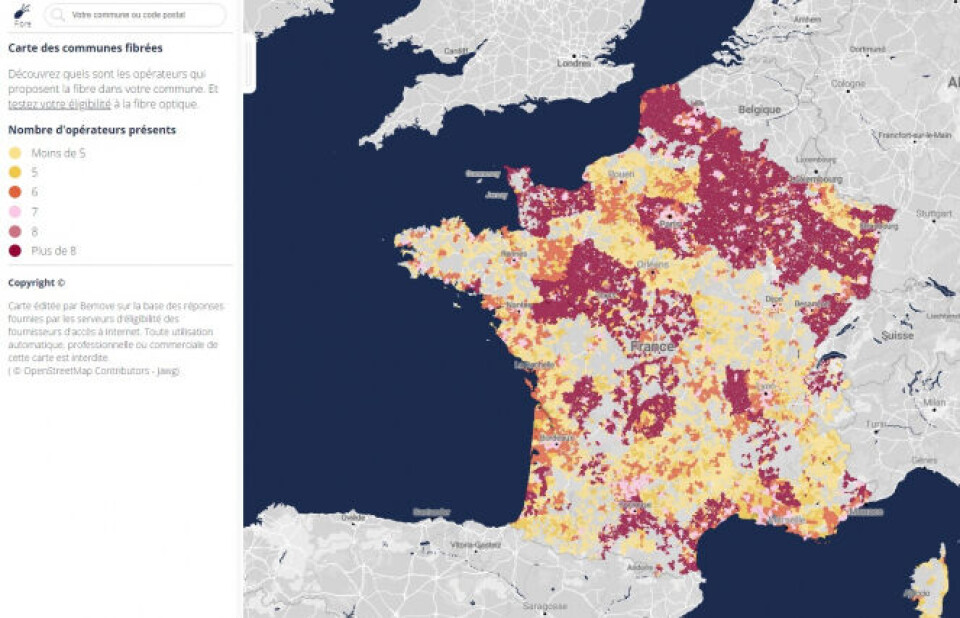-
Snake measuring up to five metres reported in Vendée
It was apparently run over by a car last week but is yet to be found
-
Mercosur trade deal explained: why French farmers are angry and will it pass?
A decisive vote is due on Friday December 19. Unions say if it passes there will be major disruption
-
Mutuelle fees set to increase in France next year: see by how much
New taxes on mutuelle companies denounced by insurance federation
Millions of French homes cannot access high-speed internet, says study
We look at the worst affected areas and what you can do to boost your internet connection

More than one-in-six households in France cannot get access to high-speed internet, a new report has found.
Consumer association UFC-Que Choisir said despite the French government’s “celebration of the formidable success” of its France Très Haut Débit plan, its “anarchic” installation of fibre-optic cables is not improving the situation and could even be making it worse.
The association used its report on Tuesday (April 18) to call on the government to:
-
Improve regulation in the sector
-
Establish a legal right to quality internet for everyone, with minimum speeds required
-
Introduce compensation for residents whose connection does not reach these levels
-
Allow fee-free cancellations in case of problems with connection or a drop in service
-
Ban subscriptions and bring in automatic compensation in case of repeated or prolonged interruptions in service.
What is the France Très Haut Débit plan and why isn’t it working?
The plan launched in 2013 and aimed to enable all people in France to access high-speed internet (higher than 30 Mbps) before the end of 2022.
And while this objective has technically been reached, the UFC-Que Choisir study found that for 17.2% of households (11.8 million people), this speed is only achievable by subscribing to wireless technology such as 4G, 5G, or satellite.
This technology is still considered ‘second class’ compared to traditional networks such as fibre optic, VDSL, or cable. The study found that these technologies often ‘ration’ data use, do not offer extra services like television, and can stop working during bad weather or high demand. They can also cost a lot more.
The study found that in practice, some activities like video calls and online gaming are functionally impossible using these alternatives, as the latency (how long it takes information to come from the server) is too slow. Latency can be up to 50 times higher via satellite than optic fibre.
Rural areas worst affected
Unsurprisingly, a lack of high-speed internet is most prevalent in rural areas. UFC-Que Choisir said a majority in Côtes-d’Armor (52.1% of consumers) and Ardèche (53.5 %) did not have access and were the worst served in mainland France.
Overall, up to 20% of residents are ineligible for a high-speed, wire-based connection in 45 departments nationwide, the study found.
More than 8.8 million people living in towns with fewer than 1,000 residents do not have a high-speed connection. What is more, 18.4% of these residents do not even have a ‘good’ speed connection of at least 8 Mbps, which was promised to everyone in 2017.
More than 10% do not even have a ‘minimal’ internet connection of at least 3 Mbps.
The study highlights that there are still major issues in rural areas, despite figures from 2021 suggesting that the rollout of fibre optic technology was being deployed faster than ADSL broadband in 60% of the areas.
Read also: Internet in rural France: New study shows how bad it really can be
Fibre optic may even be making things worse
The study also found that the rollout of fibre optic technology has been the source of multiple problems, and could even be making the connection situation worse.
Local UFC-Que Choisir associations analysed more than 500 court cases taking place in 2022, in connection with optic fibre. It found that many subscribers have experienced problems with:
-
Getting connected
-
Work being refused several times
-
Building damage
-
Poorly-done work leading to no connection
-
‘Cobbled-together’ connections to other wires
UFC-Que Choisir said that its study was just “the tip of the iceberg” when it comes to fibre optic connection issues. It added that even the federation in charge of the task admitted that between 15 and 20% of connections have had issues (meaning hundreds of thousands of problems per year).
It added that the problem is made worse when consumers do not have the means to fight internet providers or force them to solve the issue.
This leads them to a “double punishment” of not having Internet access, and having to spend hundreds of euros to solve the problem themselves (such as cancellation fees, and new subscriptions), the association said.
Read also: Where internet broadband speed is best in France
Read also: Snail-pace data, good deal: Which French mobile operator do you use?
Below is a map showing fibre connection coverage in France. Click here to open the map (in French) and search what it is like in your area.

Map: Ariase.com
What can I do about poor internet speeds in France?
We have had many messages from Connexion readers about poor internet speeds in France.
Some report that the speed is worse in the evenings, from around 18:00 onwards, especially in smaller villages. However, one said that this happened even though they have a fibre optic connection and live near Paris.
The first thing is to determine how fast (or slow) your internet speed is. To do this, you can use a free online speed test.
You can Google ‘internet speed test’, as there are many free tests online.
However, UFC-Que Choisir offers a free one here that also explains what each number means, and provides you with the details in French. This may be useful if you want to take the details to your internet provider or technician.
-
La réception (Mbps download): The speed of transfer from the network to your computer. In megabit per second (Mbps). The faster it is, the faster your internet will load pages and videos, or download files. At least 8 Mbps is recommended for an ADSL connection, while fibre optic connections can reach as many as 200 Mbps.
-
L’envoi (Mbps upload): The speed of transfer from your computer to the network. This is always much slower than the download speed. This affects how long it takes to upload files to the internet. ADSL connections offer 1-2 Mbps, while faster connections can reach 10-100 Mbps.
-
Le ping (ping or latency): The latency refers to how long it takes for information to come from the server. It is in milliseconds (ms). A low ping would be considered less than 50 ms, and fast enough for video calls on online gaming. Anything higher than 200 ms is considered slow.
Once you have established your internet speed, here are some tips for improving your connection and pushing your provider to act.
-
Try to establish where the problem is coming from (e.g. your provider, and not your hardware)
-
Check you do not have a computer virus that could be slowing down your PC or connection
-
Get a new modem. Newer machines may work better
-
Make sure your modem is placed well. Avoid putting it near your television or microwave, in a corner, or a closed cupboard, and avoid putting anything on top of it
-
Use a Wi-Fi signal repeater
-
Deactivate your automatic WiFi searching on your Windows computer once you are connected
-
Close all windows or programs that are using Wi-Fi in the background
-
Play with frequencies. Most connections have 2.4Hz and 5Hz. Try connecting to 5Hz, as it is a newer frequency and is used less
If nothing works, and you want to take it up with your provider:
-
Contact the provider’s consumer service (not the same as its customer service), if it has one. Contact details should be on your contract documentation, or the operator’s website. Send your complaint by registered mail with an acknowledgement of receipt.
-
If a solution is still not found at this point, you can take your complaint to national mediators. The government has guidelines (in French) on steps to take. These include contacting the electronic communications mediator, or the consumer mediator.
-
If you need to escalate the case further, you can even take it to a civil court.
-
The fraud and consumer office, DGCCRF, has a page with practical tips on how to start proceedings, and you can also report a problem to the office online or by phone (0809 540 550).
-
You can also contact national consumer associations for support.
-
If you cannot come to an agreement and want to change providers, you can terminate your contract. However, you might still have to pay for several months after doing so if you have a fixed-term contract.
Your feedback
Have you had trouble with slow internet in France? Have you found a good way to boost your speed in a rural area? Let us know at news@connexionfrance.com. Thank you!
Related articles
How can I find the internet speed potential of our home in France?
French countryside better connected to fibre internet than cities
























